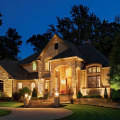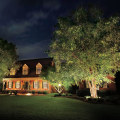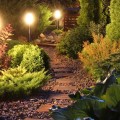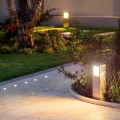While low-voltage lights generally don't provide bright light, they do provide adequate decorative lighting. Low-voltage lighting kits consist of a transformer, lighting fixtures and electrical cable. The type of bulb makes a difference, especially when it comes to brightness and energy efficiency. For low-voltage landscape lighting, LED bulbs are the preferred choice.
They are brighter than incandescent bulbs and use about 80 percent less electricity. Bulbs also last much longer than incandescent bulbs and burn out much colder. The light produced by low-voltage bulbs is sharper and has a more natural appearance than high-voltage bulbs, which produce a more diffused warm light. While it is difficult to focus the beam of a high-voltage bulb that tends to scatter light, low-voltage bulbs offer a high degree of optical control using only the reflector of the bulb.
This is because the filament of a low-voltage lamp is smaller than that of a standard lamp, and most of the lumens are focused on the beam. As a result, less light is diffused. A well-designed low-voltage lighting system must have balanced cable runs that are wired for proper voltage charging. What exactly does this mean? This means that the cables must be executed in such a way that they distribute energy as evenly as possible between each device.
In addition, the lines must be connected to the transformer so that they send the correct amount of power down the line to each device. Low-voltage landscape lighting is the most common option for residential outdoor lighting. Some advantages of 12V landscape lighting include the fact that they are easier to install, less expensive, safer, and you do not need to be a licensed electrician to work with them. Low-voltage landscape lighting reduces the risk of shocks and is easy to install as there is no need to bury the cable.
In addition, there are many more options for low-voltage landscape lighting fixtures, light bulbs, wattages and designs. For most residential applications, 12V landscape lighting is superior, preferred and more common than 120V outdoor lighting. Most people who install lighting themselves, often using a lighting kit from a box store, will encounter this problem. The kit instructs the installer to run a wire from the transformer and connect the lamps along the way in what we call the “daisy chain wiring method”.
The owner discovers that the first light is bright and looks good, while each additional light in the string dims and dims further. If there are enough lights on that wire string, it is possible that all the lights are dim and the last light will not work at all. This is because each of those lights along the way draws power from that cable, leaving less and less energy at the end of the line. Solar landscape lighting is easier to install because it does not require wiring, but rather relies on a battery that is charged throughout the day with a solar cell.
In many cases, low-voltage lighting can be used in the same spaces and for the same purposes as line-voltage lighting. Landscape lighting should create a more nuanced sensation with a color temperature between 2000 K and 3000 K. Outdoor lighting at 120 V is mainly used to illuminate large areas, using fewer but brighter fixtures, or in residential applications where there is ample upward lighting in a large canopy of large trees (although modern low-voltage LED fixtures also have enough power for this application now). This may not be a problem inside your home, but if you are looking for bright outdoor lights to illuminate a pathway, you may not want to use LED lights.
With six accessories, this set includes enough lights to illuminate a pathway or illuminate several large flower beds. Once you've decided that investing a little bit in an aesthetic landscape lighting design is the way to go, there are a few things you should keep in mind. The low-voltage light has a reduced brightness regardless of whether it is powered by solar or direct energy; the safe 12V power supply cannot create bright reflectors that are commonly connected to a standard electrical outlet. The wiring of this light makes it compatible with 12 volt landscape lighting transformers and 24 volt top output systems.
Although solar lights don't require electricity or wiring, they're usually not as bright as low-voltage lighting. Route the transformer cable along the path of the lights and use the quick-connect system to open the housing of each light and slide the electrical cable into it. Operating a lighting system at its highest voltage is what usually happens when a system needs to send enough power to the last device in a long series of daisy chained LED lights. Since 12-volt electricity does not present the risk of electric shock, low-voltage garden lighting systems are safe for homeowners to install on their own.
The other thing you need to consider is to buy a transformer with a slightly higher output power than you need when setting up the landscape lighting system. Most low-voltage landscape lighting uses a 12-gauge wire, which can operate up to 30 meters with a total load of 100 watts or less without any voltage drop. . .






